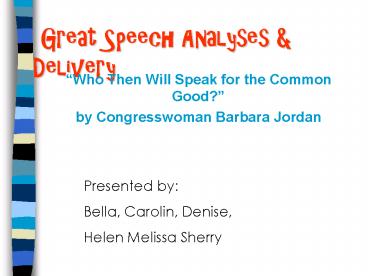Bella, Carolin, Denise, - PowerPoint PPT Presentation
Title: Bella, Carolin, Denise,
1
Great Speech Analyses Delivery
Who Then Will Speak for the Common Good? by
Congresswoman Barbara Jordan
Presented by Bella, Carolin, Denise, Helen
Melissa Sherry
2
Presentation Outline
- About Barbara Jordan and Her Speech
- Occasion Analyses
- Structure Analyses
- 4 Skills We Learn from Her Speech
- Q A
- Parallelism
- Sympathy
- Framing Quotation in Conclusion
- References
3
- Title Who Then Will Speak for the Common Good?
- Speaker Congresswoman Barbara Jordan
- Intended Audiences members of the Democratic
Party. - Occasion the 1976 convention of the Democratic
Party in New York - Purpose to call on the members of the Democratic
Party to lead the way for upholding the common
good.
4
Barbara Jordan
Photo Credit
5
Overall Structure Analyses
- Introduction (1-3)
- --Recall of memory? The history of Democratic
Party - Body (4-12)
- --Question description? Peoples indifference
of society - --Key issue? The cooperation of the whole
country - --Supporting ideas? The public officials help
- Conclusion (13)
- --Famous quote, Abraham Lincoln, the
Republican Presidentcommon will true equality
6
Key Messages Reasoning
Why do people want to turn to Democracy party
forhelp?
- ?The Democratic partys concept of governing.
7
Beliefs
- 1. Equality for all and privileges for none.
- 2. People are the source of all governmental
power. - 3. The government is not just one interest
group. - 4. They are a party of innovation.
- 5. The gap between the promise and reality of
- America can one day be finally closed.
8
Restatement
- The beliefs are the bedrock of our concept of
governing. - The beliefs represent what this country is all
about. - The beliefs are not negotiable.
9
Structure Introduction
1. In the beginning Introduce history of
the convention.
2. Then continuation of the tradition
Yet--- something is different about tonight
the uniqueness
3. A lot of I could
---to show her sincerity
10
Structure Body
4. Because the citizens of America expect more,
she states her ideal goal. --- A
national community
5. Therefore--- People turn to the Democratic
Party for help.
6. To fulfill the promise of America To
create and sustain a society in which all of
us are equal
11
- 7. Admit their mistakes and reassure people that
theyd improve. - 8 Raise problems and consequences
- 9. Who will speak for America?
- Who then will speak for the common good?
12
10. New election year? define and shape the
common good
11. What public officials should do? more
is required
12. Make assurance doubly sure (I have
confidence)
13. Conclusion Common Good Equality
quoted Abraham Lincoln
13
Skills we can apply to our speech
- 1. Question
- 2. Parallel
- 3. Sympathy
- 4. Quotation
14
Question--- If that happens, who then will
speak for America? Who then will speak for the
common good? This is the question which must be
answered in 1976. Are we to be one people bound
together by common spirit sharing in a common
endeavor or will we become a divided nation?
15
Parallel Contrast?Proposal
- I could list the many problems which Americans
have. - I could list the problems which cause people to
feel cynical, angry, frustrated problems include
lack of integrity the feeling that the grand
American experiment is failing or has failed. - I could recite these problems and then I could
sit down and offer no solutions. - But I dont choose to do that either.
16
Quotation for a Memorable Conclusion
- Now, I begin this speech by commenting to you on
the uniqueness of a Barbara Jordan making the
keynote address. - Well I am going to close my speech by quoting a
Republican President and I ask you that as you
listen to these words of Abraham Lincoln, relate
them to the concept of national community in
which every last one of us participates
17
As I would not be a slave, so I would not be a
master. This expresses my idea of Democracy.
Whatever differs from this, to the extent of the
difference is no Democracy.
---Abraham Lincoln
18
Thank you for your attention!
19
Overall Evaluation of the Speech
- Strengths (Why we consider the speech as a great
speech for analyses) - Its effective introduction conclusion
- The four skills we can learn and apply
- The Instructors Comment
- How does the speaker tailor her speech to the
occasion and how effective is the speech in
delivering her message and persuading about
equality (upheld by Democratic Party)? - How effective is her delivery (if any audio
materials is provided)?
20
Reference
- A Tribute to Barbara Jordan1936-1996
- http//www.elf.net/bjordan/default.asp
- --with her photo,
- -Opening of Barbara Jordan's address to the
Judiciary Committee considering impeachment of
then President Richard Nixon. - This led to Barbara Jordan's Keynote Speech at
the 1976 Democratic National Convention.































